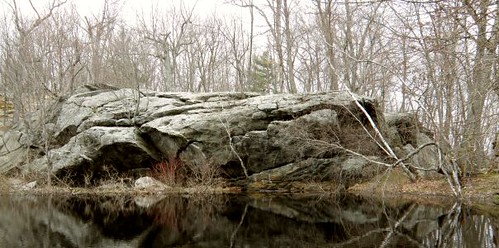
King Philip Rock/ Quinsnicket Cave formation

Cobble Rock
Vacation has once again arrived and I raced out ahead of incoming inclement weather to try and get a couple days in. Back in the late 1990's I spent a considerable amount of time in Massachusetts just to the north and east of the Rhode Island border. It is here I returned to a favorite old haunt of mine in Boulder Cave which is really a large glacial erratic with a modest overhang to it. Split-off pieces complement the "cave" experience by forming a crude exterior wall. To my surprise, a measurement of this big boy boulder came in with a girth in excess of 100 feet. Slightly closer to the Rhode Island border, I looked into a series of ledges where both conglomerates and the red slates of the Wamsutta Formation presented themselves. Much of a mystery to me was a small cave formation I examined here some 10 or 11 years ago. I thought I clearly remembered its location but it did not turn up on this visit. Finally moving into "Little Rhody" I used the Warner Trail to access rocky areas in the northeastern most parts of the State. A hiking group that passed through this area in recent times logged a small cave, although none presented itself on my inspection. Zipping over to the Town of Primrose, a geographic site from its history called the Blunders was investigated. This was a pass between two elevations of land that was a favorite picnic spot for residents in days gone by. On to another old favorite in Cobble Rock which itself was a favorite in olden days and graced many an old postcard. A couple of cave-like features and one other perched erratic also grace the area nearby.
On the second day I finally got to visit several sites that have long been on my list. Snake Den Park with its old quarries, and, ledges that use to be home to reptilian species. Hipses is an erratic that was part of the ancient boundary when Narragansett Indians sold land to Roger Williams, founder of Rhode Island. History records this as an Indian rock with its cave-like openings. One local person mentions Indians training to make arrowheads at this site. Also not far away: an ancient soapstone quarry used by Native Americans. Evidence suggests pottery made from rock at this site may have ended up as far away as Cape Cod. Ending my day were further explorations into Lincoln Woods where rumors of caves have occasionally surfaced. My journey took me to Goat Rock, Pulpit Rocks, old marble quarries, the Druid Circle, and a rocky formation some associate with both King Philip and H. P. Lovecraft.
